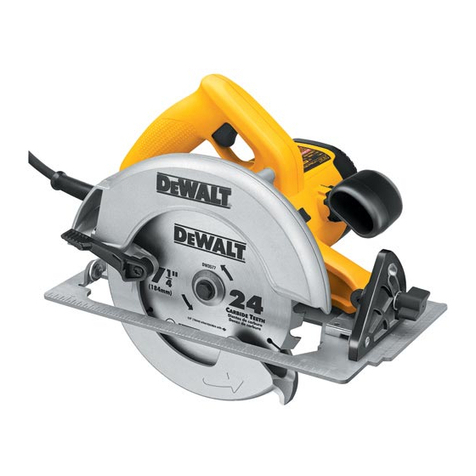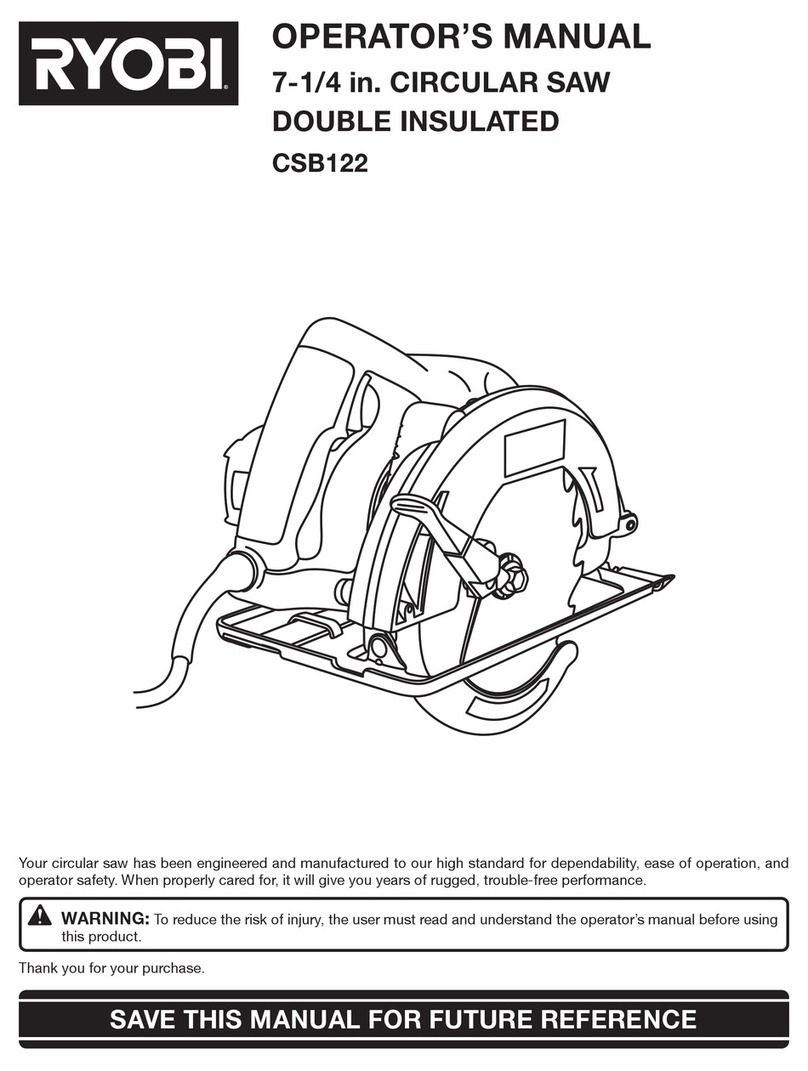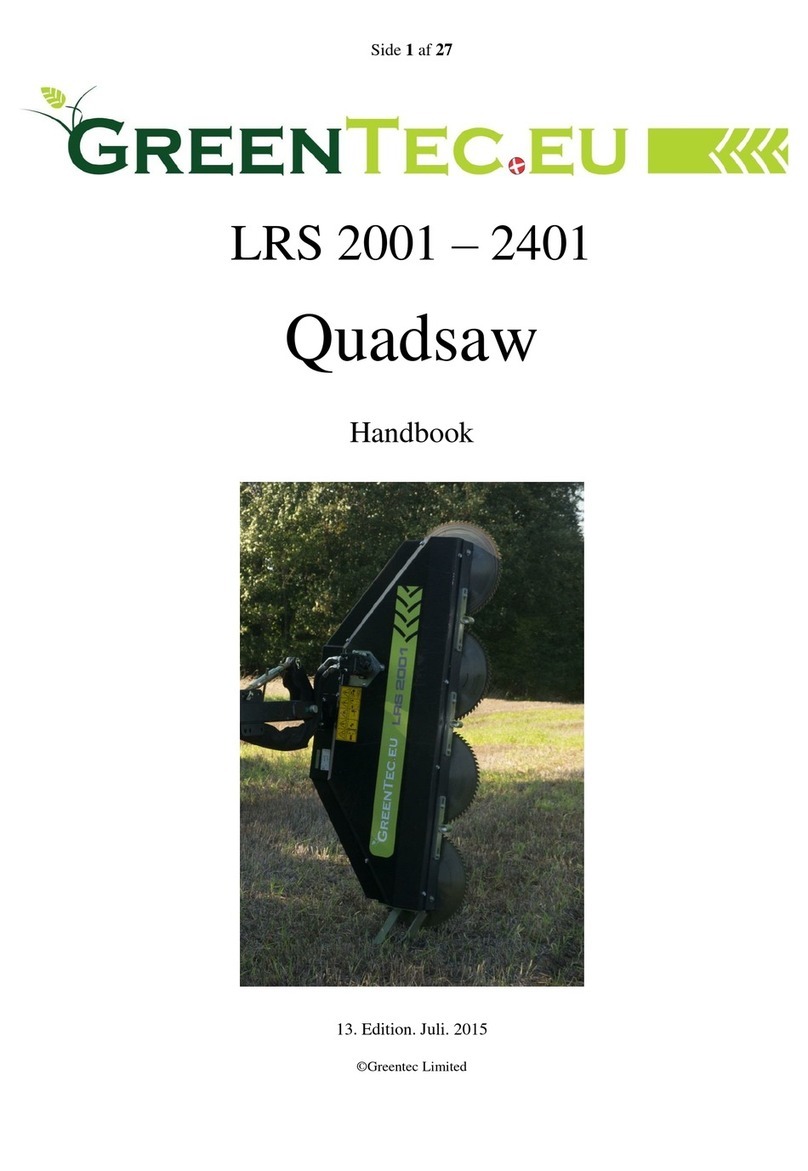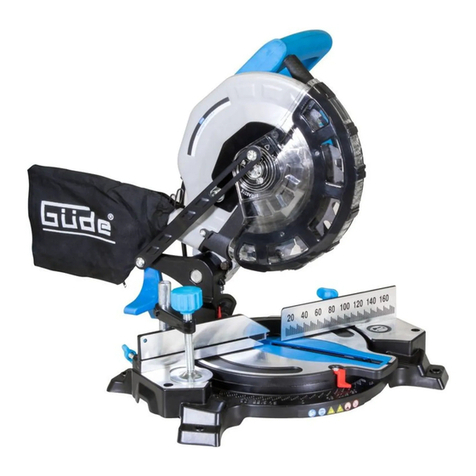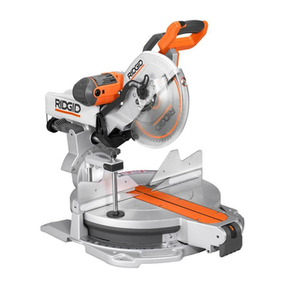PROFECO 77446 User manual

Cirkelzaag 1300W Ø185mm
77446
NL Gebruiksaanwijzing
EN Instruction manual
FR Mode d’emploi
DE Gebrauchsanleitung

2
Content
Nederlands pagina 3
English page 12
Français page 20
Deutsch Seite 29

3
Algemene veiligheidswaarschuwingen voor elektrisch
gereedschap
Lees alle veiligheidswaarschuwingen en instructies. Het niet opvolgen van de
waarschuwingen en instructies kan leiden tot elektrische schokken, brand en/of
ernstig letsel.
Bewaar alle waarschuwingen en instructies voor toekomstig gebruik.
De term "elektrisch apparaat" in de waarschuwingen verwijst naar uw elektrische
apparaten die op netstroom werken (met snoer) of naar uw elektrische apparaten die
op batterijen werken (zonder snoer).
1. Veiligheid op de werkplek
a. Houd de werkplek schoon en goed verlicht. Onoverzichtelijke of donkere
zones nodigen uit tot ongelukken.
b. Gebruik geen elektrisch gereedschap in een explosieve omgeving, zoals
in de aanwezigheid van ontvlambare vloeistoffen, gassen of stof.
Elektrisch gereedschap veroorzaakt vonken die het stof of de dampen kunnen
doen ontbranden.
c. Houd kinderen en omstanders uit de buurt wanneer u een elektrisch
apparaat bedient. Afleiding kan ertoe leiden dat u de controle verliest.
2. Elektrische veiligheid
a. De stekkers van elektrisch gereedschap moeten overeenkomen met het
stopcontact. Wijzig de stekker op geen enkele manier. Gebruik geen
verloopstekkers bij geaard elektrisch gereedschap. Niet-aangepaste stekkers
en passende stopcontacten verminderen het risico op elektrische schokken.
b. Vermijd lichamelijk contact met geaarde oppervlakken zoals leidingen,
radiatoren, fornuizen en koelkasten. Er is een verhoogd risico op
elektrische schokken als uw lichaam geaard is.
c. Stel elektrische gereedschappen niet bloot aan regen of natte
omstandigheden. Water dat in een elektrisch apparaat terechtkomt, verhoogt
het risico op elektrische schokken.
d. Misbruik het snoer niet. Gebruik het snoer nooit om het elektrische
apparaat te dragen, eraan te trekken of het los te koppelen. Houd het
snoer uit de buurt van hitte, olie, scherpe randen of bewegende delen.
Beschadigde of in de knoop geraakte snoeren verhogen het risico op
elektrische schokken.
e. Wanneer u een elektrisch gereedschap buitenshuis gebruikt, gebruik
dan een verlengsnoer dat geschikt is voor gebruik buitenshuis. Het
gebruik van een snoer dat geschikt is voor gebruik buitenshuis vermindert het
risico van een elektrische schok.
f. Als het gebruik van een elektrisch apparaat in een vochtige omgeving
onvermijdelijk is, gebruik dan een voeding met aardlekschakelaar (RCD).
Het gebruik van een aardlekschakelaar vermindert het risico van een
elektrische schok.
OPMERKING: De term aardlekschakelaar (RCD) mag worden vervangen
door de term aardlekschakelaar (GFCI) of aardlekschakelaar (ELCB).

4
3. Persoonlijke veiligheid
a. Blijf alert, kijk uit wat u doet en gebruik uw gezonde verstand wanneer u een
elektrisch apparaat bedient. Gebruik geen elektrisch gereedschap als u moe
bent of onder invloed van drugs, alcohol of medicijnen. Een moment van
onoplettendheid tijdens het bedienen van elektrisch gereedschap kan leiden
tot ernstig persoonlijk letsel.
b. Gebruik persoonlijke beschermingsmiddelen. Draag altijd oogbescherming.
Beschermende uitrusting zoals een stofmasker, veiligheidsschoenen met
antislipzool, een veiligheidshelm of gehoorbescherming die onder de juiste
omstandigheden wordt gebruikt, zal persoonlijk letsel verminderen.
c. Zorg ervoor dat de schakelaar in de uit-stand staat voordat u het apparaat
aansluit op de stroombron en/of accu, oppakt of draagt. Het dragen van
elektrisch gereedschap met uw vinger op de schakelaar of het onder spanning
zetten van elektrisch gereedschap met de schakelaar aan nodigt uit tot
ongelukken.
d. Verwijder een stelsleutel of sleutel voordat u het elektrische apparaat aanzet.
Een sleutel of sleutel die aan een draaiend deel van het elektrische apparaat
is blijven hangen, kan persoonlijk letsel veroorzaken.
e. Strek u niet te ver uit. Zorg dat u te allen tijde stevig staat en uw evenwicht
bewaart. Hierdoor kan het elektrische apparaat in onverwachte situaties beter
onder controle worden gehouden.
f. Kleed u correct. Draag geen losse kleding of juwelen. Houd uw haar, kleding
en handschoenen uit de buurt van bewegende delen. Loszittende kleding,
sieraden of lang haar kunnen in bewegende delen verstrikt raken.
g. Als er voorzieningen zijn om stof af te zuigen en op te vangen, zorg er dan
voor dat deze zijn aangesloten en op de juiste manier worden gebruikt. Het
gebruik van stofafzuiging kan stof gerelateerde gevaren verminderen.
4. Gebruik en onderhoud van elektrisch gereedschap
a. Forceer het elektrische apparaat niet. Gebruik het juiste elektrische apparaat
voor uw toepassing. Het juiste elektrische apparaat zal het werk beter en
veiliger doen in het tempo waarvoor het ontworpen is.
b. Gebruik het elektrische apparaat niet als het niet met de schakelaar aan en uit
kan worden gezet. Elk elektrisch apparaat dat niet met de schakelaar kan
worden bediend, is gevaarlijk en moet worden gerepareerd.
c. Haal de stekker uit het stopcontact en/of haal de accu uit het elektrische
apparaat voordat u het apparaat aanpast, toebehoren verwisselt of elektrisch
gereedschap. Dergelijke preventieve veiligheidsmaatregelen verminderen het
risico dat het elektrische apparaat per ongeluk wordt gestart.
d. Berg elektrische apparaten die niet gebruikt worden buiten het bereik van
kinderen op en sta niet toe dat het elektrische apparaat bediend wordt door
personen die onbekend zijn met het apparaat of met deze instructies.
Elektrische gereedschappen zijn gevaarlijk in de handen van ongetrainde
gebruikers.
e. Onderhoud elektrische apparaten. Controleer op onjuiste uitlijning of vastlopen
van bewegende delen, op breuk van onderdelen en op elke andere conditie
die de werking van het elektrische apparaat kan beïnvloeden. Laat het
elektrische apparaat bij beschadiging repareren voordat u het gebruikt. Veel
ongelukken worden veroorzaakt door slecht onderhouden elektrische
gereedschappen.

5
f. Houd snijwerktuigen scherp en schoon. Goed onderhouden snijwerktuigen
met scherpe snijkanten zullen minder snel vastlopen en zijn gemakkelijker te
controleren.
g. Gebruik het elektrische apparaat, accessoires en gereedschapsbits enz. in
overeenstemming met deze instructies, rekening houdend met de
werkomstandigheden en de uit te voeren werkzaamheden. Gebruik van het
motorapparaat voor andere dan de bedoelde werkzaamheden kan tot
gevaarlijke situaties leiden.
Service
Laat uw elektrische apparaat onderhouden door een gekwalificeerde reparateur
die uitsluitend identieke vervangingsonderdelen gebruikt. Dit waarborgt dat de
veiligheid van het elektrische apparaat gehandhaafd blijft.
5. Specifieke veiligheidsvoorschriften
a. GEVAAR: Houd uw handen uit de buurt van het snijgebied en het mes. Houd
uw tweede hand op de extra handgreep of de motorbehuizing. Als beide
handen de zaag vasthouden, kunnen ze niet worden doorgezaagd door het
zaagblad met de originele instructies.
b. Grijp niet onder het werkstuk. De beschermkap kan u niet beschermen tegen
het blad onder het werkstuk.
c. Pas de zaagdiepte aan de dikte van het werkstuk aan. Minder dan een
volledige tand van de zaagtanden moet zichtbaar zijn onder het werkstuk.
d. Houd het te zagen stuk nooit in uw handen of over uw been. Zet het werkstuk
vast op een stabiel platform. Het is belangrijk om het werkstuk goed te
ondersteunen om blootstelling van het lichaam, vastbinden van het blad of
verlies van controle te minimaliseren.
e. Houd het elektrische gereedschap bij geïsoleerde grijpvlakken vast wanneer u
een bewerking uitvoert waarbij het snijgereedschap in contact kan komen met
verborgen bedrading of het eigen snoer. Contact met een "stroom voerende"
draad zal ook blootliggende metalen delen van het elektrische gereedschap
"stroom voerend" maken en de gebruiker een schok geven.
f. Gebruik bij het rippen altijd een schulpgeleider of een rechte geleider. Dit
verbetert de nauwkeurigheid van de snede en vermindert de kans op
bladbinding.
g. Gebruik altijd bladen met de juiste maat en vorm (ruitvormig versus rond) van
de asgaten. Bladen die niet overeenstemmen met de montage hardware van
de zaag zullen excentrisch lopen, waardoor u de controle verliest.
h. Gebruik nooit beschadigde of verkeerde bladringen of bouten De bladringen
en bouten zijn speciaal ontworpen voor uw zaag, voor optimale prestaties en
veilig gebruik.

6
Oorzaken en voorkomen van terugslag door de bediener:
a. Terugslag is een plotselinge reactie op een vastgeklemd, gebonden of
verkeerd uitgelijnd zaagblad, waardoor een ongecontroleerde zaag omhoog
en uit het werkstuk wordt getild in de richting van de bediener;
b. Als het zaagblad klemt of vastgebonden is doordat de zaagsnede naar
beneden sluit, blokkeert het zaagblad en drijft de motorreactie het apparaat
snel terug in de richting van de bediener;
c. Als het blad tijdens de snede gedraaid of verkeerd uitgelijnd raakt, kunnen de
tanden aan de achterkant van het blad zich ingraven in de bovenkant van het
hout, waardoor het blad uit de zaagsnede klimt en terugspringt in de richting
van de bediener.
Terugslag is het gevolg van verkeerd gebruik van de zaag en/of onjuiste
werkprocedures of omstandigheden en kan worden vermeden door de
juiste voorzorgsmaatregelen te nemen, zoals hieronder aangegeven.
a. Houd de zaag met beide handen stevig vast en plaats uw armen om
terugslagkrachten te weerstaan. Plaats uw lichaam aan weerszijden van het
zaagblad, maar niet in lijn met het zaagblad.
b. Wanneer het zaagblad vastloopt, of wanneer u om welke reden dan ook een
zaagsnede onderbreekt, laat u de trekker los en houdt u de zaag onbeweeglijk
in het materiaal totdat het zaagblad volledig tot stilstand is gekomen. Probeer
nooit de zaag van het werk te verwijderen of de zaag naar achteren te trekken
terwijl het blad in beweging is, anders kan terugslag optreden.
c. Bij het opnieuw starten van een zaag in het werkstuk, centreer het zaagblad in
de kerf en controleer of de zaagtanden niet in het materiaal zijn vastgelopen.
d. Ondersteun grote panelen om het risico op afknellen van het zaagblad en
terugslag tot een minimum te beperken.
e. Gebruik geen botte of beschadigde zaagbladen. Ongeslepen of onjuist
ingestelde zaagbladen produceren een smalle zaagsnede, wat leidt tot
overmatige wrijving, bladbinding en terugslag.
f. De vergrendelingshendels voor bladdiepte en -afschuining moeten goed
vastzitten voordat u gaat zagen. Als de bladafstelling verschuift tijdens het
zagen, kan dit leiden tot vastbinden en terugslag.
g. Wees extra voorzichtig bij het zagen in bestaande muren of andere blinde
gebieden. Het voorlopende zaagblad kan in voorwerpen snijden die terugslag
kunnen veroorzaken.

7
6. Functie onderste bewaker
a. Controleer voor elk gebruik of de onderste beschermkap goed sluit. Gebruik
de zaag niet als de onderste beschermkap niet vrij beweegt en niet
onmiddellijk sluit. De onder bescherming nooit vastklemmen of vastbinden in
de open stand. Als de zaag per ongeluk valt, kan de onder bescherming
verbogen zijn. Zet de onderkap omhoog met de intrekhandgreep en controleer
of hij vrij beweegt en het zaagblad of andere onderdelen niet raakt, in alle
zaaghoeken en -dieptes.
b. Controleer de werking van de veer van de onderste beschermkap. Als de
beschermkap en de veer niet goed werken, moeten ze voor gebruik worden
nagekeken. De onderste beschermkap kan traag werken als gevolg van
beschadigde onderdelen, kleverige aanslag of opeenhoping van vuil.
c. De onderste beschermkap mag alleen handmatig worden ingetrokken voor
speciale zaagsneden, zoals "inval- en samengestelde snede". Zet de onderste
beschermkap omhoog door de hendel in te trekken en laat de onderste
beschermkap los zodra het zaagblad het materiaal raakt. Voor alle andere
zaagbewerkingen moet de onderste beschermkap automatisch werken.
d. Controleer altijd of de onder bescherming het zaagblad bedekt voordat u de
zaag op de werkbank of vloer plaatst. Een onbeschermd, teruglopend
zaagblad zal de zaag achteruit doen lopen en alles doorzagen wat zich op zijn
weg bevindt. Let op de tijd die het zaagblad nodig heeft om te stoppen nadat
de schakelaar is losgelaten.

8
7. Technische gegevens
a. Technische specificaties
Spanning & Frequentie:
220-240V- 50Hz
Ingangsvermogen:
1300W
Onbelast toerental:
5800 toeren per minuut
Bladgrootte:
185 mm
Max. snijdiepte:
62 mm @ 90 graden
42 mm @ 45 graden
b. Onderdelen
1. Zaagblad
2. Beschermkap ondermes
3. Basisplaat
4. Hendel voor onderste beschermkap
5. Stofafzuigpoort
6. Bovenste bladbeschermer
7. Scheurgeleider
8. Inbussleutel voor mes
9. Bevel Schaalbeugel
10.Afschuining Klemhefboom
11.Borgschroef van de scheurgeleider
12.Bladbout en sluitring
13.Knop voor vergrendeling
14.ON/OFF-schakelaar
15.Dieptegeleiderbeugel
16.Diepteklemhendel
17.Achterste Motor
18.Knop voor spilvergrendeling

9
8. Montage
WAARSCHUWING: Alvorens werkzaamheden aan het apparaat zelf uit te
voeren, moet de hoofdstekker uit het stopcontact worden verwijderd.
Om onbedoeld starten te voorkomen, moet u ervoor zorgen dat de
vergrendelknop niet is ingeschakeld voordat u de stekker in het stopcontact steekt
en dat uw vinger niet in aanraking komt met de trekker van de aan/uit-schakelaar.
Monteren/vervangen van het zaagblad
a. Leg deze cirkelzaag op zijn kant op een vlakke ondergrond. (Raad u aan de
bodemplaat (3) op zijn maximale diepte te zetten, zodat hij gemakkelijk te
bedienen is).
b. Duw de spindelvergrendelknop (18) in de richting van het hoofdhuis en blijf
deze stevig ingedrukt houden.
c. Draai de mesklembout tegen de klok in met behulp van de bijgeleverde
moersleutel (8).
d. Verwijder de mesklemschroef met sluitring en buitenflens en laat de
spindelvergrendelknop (18) los.
e. Breng de onderste beschermkap (2) omhoog met behulp van de hendel voor
onderste beschermkap, en verwijder vervolgens het zaagblad.
f. Reinig de zaagbladflenzen. Draai de onderste beschermkap (2) naar de
maximale beschermingspositie en bewaar deze en monteer vervolgens het
nieuwe zaagblad op de uitgaande as en tegen de binnenste flens.
g. Zorg ervoor dat de zaagtanden en de pijl op het zaagblad in dezelfde richting
staan als de pijl op de hoofdbehuizing.
h. Maak de onderste beschermkap (2) los.
i. Plaats de buitenflens terug met de holle kant naar binnen, druk eerst de
spindelvergrendelknop (18) in en draai de bladklembout vast.
j. Controleer of het zaagblad vrij loopt door het blad met de hand te draaien.
Installatie van de sleepgeleider (zie Fig.2)
Voer de volgende stappen uit om de scheurgeleider op de machine te installeren.
a. Trek de stekker van uw cirkelzaag uit het stopcontact.
b. Steek de schulpgeleider (7) door de drie gleuven van
de bodemplaat (3) aan de voorkant van de zaag, te
beginnen met de gleuf in de linker zijkant van de
bodemplaat.
c. Schuif de linker geleider door de gleuven totdat hij aan
de rechterkant van de basisplaat uitsteekt.
d. Stel de schulpgeleider in op de gewenste zaagbreedte
en draai vervolgens de borgschroef van de schulpgeleider (11) stevig vast.
Werking
WAARSCHUWING: Let op de juiste netspanning! De spanning van de
stroombron moet overeenkomen met de spanning die op het typeplaatje
van het apparaat vermeld staat.

10
Aan/uit-schakelaar
a. Sluit de stekker aan op de stroomvoorziening, het stroomlampje brandt totdat
de stekker uit het stopcontact is.
b. Schakel het apparaat in of uit door de schakelaar in te drukken of los te laten.
c. Voor continu gebruik volstaat het de vergrendelknop aan de linkerzijde van het
handvat in te drukken.
Snij methodes
Parallel snijden afstellen
a. Draai de vergrendelknop van de randgeleider los.
b. Schuif de randgeleider door de sleuven in de schoen tot de gewenste breedte.
c. Draai de vergrendelknop vast om hem in de positie vast te zetten.
d. Zorg ervoor dat de randgeleider over de gehele lengte tegen het hout rust om
een consistente parallelle snede te verkrijgen.
Diepteafstelling (Zie Fig.3)
a. Trek de stekker van uw cirkelzaag uit het stopcontact.
b. Draai de hendel van de diepteklem op de
dieptegeleider aan de achterkant van de zaag los.
c. Houd de basisplaat tegen de rand van het werkstuk
en til het lichaam van de zaag op totdat het zaagblad
op de juiste diepte staat die door de dieptemeter wordt
bepaald (lijn de schaallijn uit).
d. Zet de basisplaat vast door de hendel vast te draaien.
ATTENTIE: Altijd de juiste zaagdiepte-instelling aanhouden. Voor alle
zaagsneden mag de zaagdiepte niet meer dan 1/4Honder het te zagen materiaal
zijn. Een te grote zaagdiepte verhoogt de kans op terugslag van de zaag.
Hoekinstelling (Zie Fig.4)
a. Draai de schuine schaalbeugel los voor hoekinstelling.
b. Duw de grondplaat omlaag en stel deze in op de
gewenste hoek tussen 0° en 45°
c. Draai de beugel voor de afschuiningsschaal vast.
Vervangen van de koolborstels
Om veiligheidsredenen schakelt de machine automatisch uit als de koolborstels
zo versleten zijn dat ze geen contact meer hebben met de motor. In dat geval
moeten de koolborstels worden vervangen door een paar soortgelijke koolborstels
die verkrijgbaar zijn via de dienst na verkoop of een gekwalificeerde vakman.
Draai het koolborsteldeksel los tegen de wijzers van de klok in met behulp van
een schroevendraaier, open het deksel en verwijder de koolborstels. Als ze 6 mm
of minder zijn, moeten ze beide worden vervangen. Plaats nieuwe koolborstels en
plaats het borstelhuis terug.

11
Accessoires
BESCHRIJVING
TOEPASSING
24 Tanden TCT Premium zaagblad
Zagen van hout, plastic en andere
zachte materialen
9. Onderhoud
Gebruik nooit agressieve reinigingsmiddelen of oplosmiddelen voor het
reinigen.
a. Om ongevallen te voorkomen, altijd de stekker van de motorzaag uit het
stopcontact halen alvorens de motorzaag schoon te maken of onderhoud te
plegen De motorzaag kan het doeltreffendst worden schoongemaakt met
perslucht. Draag altijd een veiligheidsbril bij het gebruik van perslucht. Als
perslucht niet beschikbaar is, gebruik dan een borstel om stof en spaanders
van de zaag te verwijderen.
b. Motorventilatieopeningen en schakelaar hendels moeten schoon en vrij van
vreemde voorwerpen worden gehouden. Probeer niet schoon te maken door
puntige voorwerpen door openingen te steken.
c. Gebruik nooit bijtende middelen om kunststof onderdelen schoon te maken.
Zoals: benzine, tetrachloorkoolstof, gechloreerde schoonmaakmiddelen,
ammoniak en huishoudelijke schoonmaakmiddelen die ammoniak bevatten.
Gebruik geen van deze middelen om de zaag schoon te maken.
d. Laat een erkend servicecentrum de versleten koolborstels onderzoeken en/of
vervangen in geval van overmatig parkeren.
e. Een zeker teken van een dof zaagblad is de noodzaak om de zaag naar voren
te duwen in plaats van te geleiden bij het maken van een zaagsnede. Breng
het blad naar een servicecentrum om het te laten slijpen.
f. Houd de machine altijd schoon.
g. Als u schade vaststelt, raadpleeg dan de opengewerkte tekening en de
onderdelenlijst om precies te bepalen welk vervangingsonderdeel u bij onze
klantendienst moet bestellen.
h. Reinig de behuizing alleen met een vochtige doek. Gebruik geen
oplosmiddelen! Daarna goed afdrogen.
i. Als het netsnoer van dit elektrische apparaat beschadigd is, moet het worden
vervangen door een soortgelijk snoer dat verkrijgbaar is via de
serviceorganisatie of een gekwalificeerde, erkende monteur.

12
General safety warnings for power tools
Read all safety warnings and instructions. Failure to follow the warnings and
instructions may result in electric shock, fire and/or serious injury.
Keep all warnings and instructions for future reference.
The term "electrical appliance" in the warnings refers to your mains-operated
(corded) electrical appliances or your battery-operated (cordless) electrical
appliances.
1. Safety at the workplace
a. Keep the workplace clean and well lit. Cluttered or dark areas invite
accidents.
b. Do not use power tools in explosive atmospheres, such as in the
presence of flammable liquids, gases or dusts. Power tools create sparks
which may ignite the dust or fumes.
c. Keep children and bystanders away when operating a power tool.
Distractions can cause you to lose control.
2. Electrical safety
a. The plugs of power tools must match the socket. Do not modify the plug in
any way. Do not use adapters with grounded power tools. Non-matching plugs
and matching outlets reduce the risk of electric shock.
b. Avoid physical contact with grounded surfaces such as pipes, radiators,
cookers and refrigerators. There is an increased risk of electric shock if your
body is earthed.
c. Do not expose power tools to rain or wet conditions. Water entering a
power tool increases the risk of electric shock.
d. Do not misuse the cord. Never use the cord to carry, pull or disconnect the
power tool. Keep the cord away from heat, oil, sharp edges or moving parts.
Damaged or tangled cords increase the risk of electric shock.
e. When using a power tool outdoors, use an extension cord suitable for
outdoor use. The use of a cord suitable for outdoor use reduces the risk of
electric shock.
f. If the use of an electrical appliance in a damp environment is
unavoidable, use a power supply with a residual current device (RCD).
The use of an RCD reduces the risk of electric shock.
NOTE: The term residual current device (RCD) may be replaced by the term
residual current device (GFCI) or residual current device (ELCB).

13
3. Personal safety
a. Stay alert, watch what you are doing and use common sense when operating
a power tool. Do not use a power tool if you are tired or under the influence of
drugs, alcohol or medication. A moment's inattention while operating a power
tool can result in serious personal injury.
b. Use personal protective equipment. Always wear eye protection. Protective
equipment such as dust mask, non-slip safety shoes, safety helmet or hearing
protection used under proper conditions will reduce personal injuries.
c. Make sure the switch is in the off position before connecting the tool to the
power source and/or battery, picking up or carrying. Carrying power tools with
your finger on the switch or energizing power tools with the switch on invites
accidents.
d. Remove a spanner or key before turning on the power tool. A spanner or key
left attached to a rotating part of the power tool may cause personal injury.
e. Do not overreach. Be sure to stand firmly and always keep your balance. This
will help control the power tool in unexpected situations.
f. Dress appropriately. Do not wear loose clothing or jewellery. Keep your hair,
clothing and gloves away from moving parts. Loose clothing, jewellery or long
hair can become entangled in moving parts.
g. If dust extraction and collection facilities are provided, make sure they are
connected and used properly. The use of dust extraction can reduce dust-
related hazards.
4. Use and maintenance of power tools
a. Do not force the power tool. Use the correct power tool for your application.
The right power tool will do the job better and safer at the rate it is designed.
b. Do not use the power tool if it cannot be turned on and off with the switch. Any
power tool that cannot be controlled with the switch is dangerous and must be
repaired.
c. Unplug the power tool and/or remove the battery pack from the power tool
before making any adjustments, changing accessories or using power tools.
Such preventive safety measures reduce the risk of starting the power tool
accidentally.
d. Store idle power tools out of the reach of children and do not allow persons
unfamiliar with the power tool or these instructions to operate the power tool.
Power tools are dangerous in the hands of untrained users.
e. Maintain power tools. Check for misalignment or binding of moving parts,
breakage of parts and any other condition that may affect the power tool's
operation. If damaged, have the power tool repaired before use. Many
accidents are caused by poorly maintained power tools.
f. Keep cutting tools sharp and clean. Properly maintained cutting tools with
sharp cutting edges are less likely to seize and are easier to control.
g. Use the power tool, accessories and tool bits etc. in accordance with these
instructions, taking into account the working conditions and the work to be
performed. Using the power tool for work other than that intended may result
in dangerous situations.
Service
Have your power tool serviced by a qualified repair person using only identical
replacement parts. This will ensure that the safety of the power tool is maintained.

14
5. Specific safety instructions
a. DANGER: Keep your hands away from the cutting area and the blade. Keep
your second hand on the additional handle or the engine housing. If both
hands are holding the saw, they cannot cut through the blade with the original
instructions.
b. Do not reach under the workpiece. The protective cover cannot protect you
from the blade under the workpiece.
c. Adjust the depth of cut to the thickness of the workpiece. Less than one full
tooth of the blade should be visible under the workpiece.
d. Never hold the workpiece in your hands or over your leg. Secure the
workpiece on a stable platform. It is important to support the workpiece
properly to minimize body exposure, blade binding or loss of control.
e. Hold the power tool by insulated gripping surfaces when performing any
operation where the cutting tool may encounter concealed wiring or its own
cord. Contact with a "live" wire will also make exposed metal parts of the
power tool "live" and shock the user.
f. Always use a rip fence or straight fence when ripping. This improves the
accuracy of the cut and reduces the risk of blade binding.
g. Always use blades with the correct size and shape (diamond shaped versus
round) of the shaft holes. Blades that do not match the saw's mounting
hardware will run eccentrically, causing you to lose control.
h. Never use damaged or incorrect blade rings or bolts the blade rings and bolts
are designed specifically for your saw, for optimum performance and safe use.
Causes and prevention of kickback by the operator:
a. Kickback is a sudden reaction to a clamped, bound or misaligned saw blade,
causing an uncontrolled saw lift up and out of the workpiece in the direction of
the operator;
b. If the guide bar is clamped or bound due to the cut closing down, the guide bar
locks and the motor reaction drives the tool quickly back towards the operator;
c. If the blade becomes twisted or misaligned during the cut, the teeth on the rear
of the blade may dig into the top of the wood, causing the blade to climb out of
the kerf and recede back towards the operator.

15
Kickback is the result of improper use of the saw and/or incorrect working
procedures or conditions and can be avoided by taking the appropriate
precautions, as indicated below.
a. Hold the saw firmly with both hands and position your arms to resist kickback
forces. Place your body on either side of the guide bar, but not in line with it.
b. If the guide bar jams, or if you interrupt a cut for any reason, release the
trigger and hold the saw motionless in the material until the guide bar has
come to a complete stop. Never try to remove the saw from the work or pull
the saw backwards while the blade is moving, otherwise kickback may occur.
c. When restarting a saw in the workpiece, centre the saw blade in the kerf and
check that the saw teeth have not jammed in the material.
d. Support large panels to minimise the risk of pinching the saw blade and
kickback.
e. Do not use blunt or damaged saw blades. Unsharpened or improperly
adjusted saw blades produce a narrow cut, leading to excessive friction, blade
binding and kickback.
f. The locking levers for blade depth and bevel must be tightened securely
before cutting. If the blade adjustment shifts while cutting, it may cause binding
and kickback.
g. Take extra care when sawing in existing walls or other blind areas. The
leading saw blade may cut into objects that may cause kickback.
6. Function of lower guard
a. Check that the lower protective cover closes properly before each use. Do not
use the saw if the lower guard does not move freely and does not close
immediately. Never clamp or bind the lower guard in the open position. If the
saw accidentally falls, the lower guard may be bent. Raise the lower guard
using the retractable handle and check that it moves freely and does not touch
the guide bar or other components, at all cutting angles and depths.
b. Check the function of the spring of the lower guard. If the guard and spring are
not working properly, they should be checked before use. The lower guard
may operate slowly due to damaged parts, sticky deposits or accumulation of
dirt.
c. The lower guard may only be retracted manually for special cuts, such as
"plunge cut and compound cut". Raise the lower guard by pulling the lever and
release the lower guard as soon as the saw blade touches the material. For all
other cutting operations, the lower guard should operate automatically.
d. Always check that the lower guard covers the saw blade before placing the
saw on the workbench or floor. An unprotected, receding saw blade will cause
the saw to run backwards and cut through anything in its path. Note the time it
takes for the guide bar to stop after the switch is released.

16
7. Technical data
a. Technical specifications
Voltage & Frequency:
220-240V- 50Hz
Input power:
1300W
No load speed:
5800 rpm
Blade size:
185 mm
Max. depth of cut:
62 mm @ 90 degrees
42 mm @ 45 degrees
b. Parts
1. Saw blade
2. Blade guard
3. Base plate
4. Lever for lower protective cover
5. Dust extraction port
6. Upper blade protector
7. Tear-off guide
8. Allen key for blade
9. Scale bar
10.Chamfer Clamp
11.Locking screw of the rip fence
12.Blade bolt and washer
13.Locking knob
14.ON/OFF switch
15.Depth guide bracket
16.Depth lever
17.Rear Motor
18.Spindle lock button

17
8. Mounting
WARNING: Before carrying out any work on the machine, the main plug
must be removed from the socket.
To prevent unintentional start-up, make sure that the lock button is not engaged
before you insert the plug and that your finger does not touch the trigger of the
on/off switch.
Mounting/replacing the saw blade
a. Lay this circular saw on its side on a flat surface. (We recommend that you set
the base plate (3) to its maximum depth so that it is easy to operate).
b. Push the spindle lock button (18) in the direction of the main body and keep it
firmly pressed down.
c. Turn the blade clamp bolt counter clockwise using the spanner (8) provided.
d. Remove the knife clamp bolt with washer and outer flange and release the
spindle lock button (18).
e. Raise the lower protective cover (2) using the lower protective cover lever and
then remove the saw blade.
f. Clean the saw blade flanges. Turn the lower protective cap (2) to the
maximum protective position and keep it there, then mount the new saw blade
on the output shaft and against the inner flange.
g. Make sure the saw teeth and the arrow on the saw blade are in the same
direction as the arrow on the main housing.
h. Loosen the lower protective cap (2).
i. Replace the outer flange with the hollow side inwards, first press the spindle
lock button (18) and then tighten the blade clamp bolt.
j. Check that the saw blade runs freely by turning it by hand.
Installation of the draglink (see Fig.2)
Perform the following steps to install the rip fence on the machine.
a. Pull the plug of your circular saw out of the mains
socket.
b. Insert the rip fence (7) through the three slots of the
base plate (3) at the front of the saw, starting with
the slot in the left side of the base plate.
c. Slide the left guide through the slots until it
protrudes on the right side of the base plate.
d. Adjust the rip fence to the desired cutting width and
then tighten the rip fence locking screw (11) firmly.
Operation
WARNING: Ensure that the mains voltage is correct! The voltage of the
power source must correspond to the voltage specified on the type plate of
the appliance.

18
On/off switch
a. Connect the plug to the power supply, the power light is on until the plug is
removed from the socket.
b. Switch the unit on or off by pressing or releasing the switch.
c. For continuous use, simply press the lock button on the left-hand side of the
handle.
Cutting methods
Adjusting parallel cuts
a. Loosen the locking knob of the edge guide.
b. Slide the edge guide through the slots in the shoe to the desired width.
c. Tighten the locking knob to secure it in position.
d. Make sure that the edge guide rests against the wood for its entire length to
achieve a consistent parallel cut.
Depth adjustment (See Fig.3)
a. Pull the plug of your circular saw out of the mains
socket.
b. Loosen the depth guide clamp lever on the back of the
saw.
c. Hold the base plate against the edge of the workpiece
and lift the body of the saw until the saw blade is at
the correct depth determined by the depth gauge
(align the scale line).
d. Secure the base plate by tightening the lever.
ATTENTION: Always maintain the correct cutting depth setting. The cutting depth
for all cuts should be no more than 1/4Hbelow the material to be cut. Excessive
cutting depth increases the risk of kickback.
Angle adjustment (See Fig.4)
a. Loosen the tilted scale bracket for angle adjustment.
b. Push down the base plate and adjust to the desired angle
between 0° and 45
c. Tighten the bevel scale bracket.
Replacing the carbon brushes
For safety reasons, the machine shuts down automatically if the carbon brushes
are so worn that they no longer make contact with the motor. In this case, the
carbon brushes must be replaced with a pair of similar carbon brushes available
from the after-sales service or a qualified professional. Using a screwdriver,
loosen the carbon brush cover counter clockwise, open the cover and remove the
carbon brushes. If they are 6 mm or less, they must both be replaced. Fit new
carbon brushes and replace the brush housing.

19
Accessories
DESCRIPTION
APPLICATION
24 Toothed TCT Premium Saw Blade
Cutting wood, plastic and other soft
materials
9. Maintenance
Never use aggressive cleaning agents or solvents for cleaning.
a. To avoid accidents, always unplug the saw before cleaning or servicing it the
most effective way to clean the saw is with compressed air. Always wear
safety glasses when using compressed air. If compressed air is not available,
use a brush to remove dust and chips from the saw.
b. Engine vents and switch levers must be kept clean and free of foreign objects.
Do not attempt to clean by inserting pointed objects through openings.
c. Never use corrosive substances to clean plastic parts. Such as: petrol, carbon
tetrachloride, chlorinated detergents, ammonia and household cleaners
containing ammonia. Do not use any of these agents to clean the saw.
d. In case of excessive parking, have an authorized service centre examine
and/or replace the worn-out carbon brushes.
e. A sure sign of a dull saw blade is the need to push the saw forward instead of
guiding it when making a cut. Take the blade to a service centre to have it
sharpened.
f. Always keep the machine clean.
g. If you notice any damage, refer to the exploded view and the parts list to
determine exactly which replacement part to order from our customer service
department.
h. Only clean the housing with a damp cloth. Do not use solvents! Then dry well.
i. If the power cord of this electrical appliance is damaged, it must be replaced
with a similar cord available from the service organisation or a qualified,
authorised technician.

20
Avertissements généraux de sécurité pour les outils
électriques
Lisez tous les avertissements et instructions de sécurité. Le non-respect des
avertissements et des instructions peut entraîner un choc électrique, un incendie
et/ou des blessures graves.
Conservez tous les avertissements et instructions pour pouvoir vous y référer
ultérieurement.
Le terme "appareil électrique" dans les avertissements fait référence à vos appareils
électriques fonctionnant sur secteur (avec fil) ou à vos appareils électriques
fonctionnant sur batterie (sans fil).
1. Sécurité sur le lieu de travail
a. Maintenez le lieu de travail propre et bien éclairé. Les zones encombrées
ou sombres sont propices aux accidents.
b. N'utilisez pas d'outils électriques dans des atmosphères explosives, par
exemple en présence de liquides, de gaz ou de poussières inflammables.
Les outils électriques produisent des étincelles qui peuvent enflammer la
poussière ou les fumées.
c. Tenez les enfants et les spectateurs à l'écart lorsque vous utilisez un
outil électrique. Les distractions peuvent vous faire perdre le contrôle.
2. Sécurité électrique
a. Les fiches des outils électriques doivent correspondre à la prise. Ne
modifiez pas la fiche de quelque façon que ce soit. N'utilisez pas
d'adaptateurs avec des outils électriques mis à la terre. Des fiches non
assorties et des prises assorties réduisent le risque de choc électrique.
b. Évitez tout contact physique avec les surfaces mises à la terre, telles
que les tuyaux, les radiateurs, les cuisinières et les réfrigérateurs. Il
existe un risque accru de choc électrique si votre corps est mis à la terre.
c. N'exposez pas les outils électriques à la pluie ou à l'humidité. La
pénétration d'eau dans un outil électrique augmente le risque de choc
électrique.
d. Ne faites pas un mauvais usage du cordon. N'utilisez jamais le cordon
pour porter, tirer ou débrancher l'outil électrique. Gardez le cordon à
l'écart de la chaleur, de l'huile, des bords tranchants ou des pièces mobiles.
Des cordons endommagés ou emmêlés augmentent le risque de choc
électrique.
e. Lorsque vous utilisez un outil électrique à l'extérieur, utilisez une
rallonge adaptée à une utilisation en extérieur. L'utilisation d'un cordon
adapté à une utilisation en extérieur réduit le risque de choc électrique.
f. Si l'utilisation d'un appareil électrique dans un environnement humide
est inévitable, utilisez une alimentation électrique avec un dispositif à
courant résiduel (RCD). L'utilisation d'un disjoncteur différentiel réduit le
risque de choc électrique.
REMARQUE : Le terme dispositif à courant résiduel (RCD) peut être
remplacé par le terme dispositif à courant résiduel (GFCI) ou dispositif à
courant résiduel (ELCB).
Table of contents
Languages:
Popular Saw manuals by other brands

Kval
Kval 979-2 Operation manual

Craftsman
Craftsman 315.10721 owner's manual
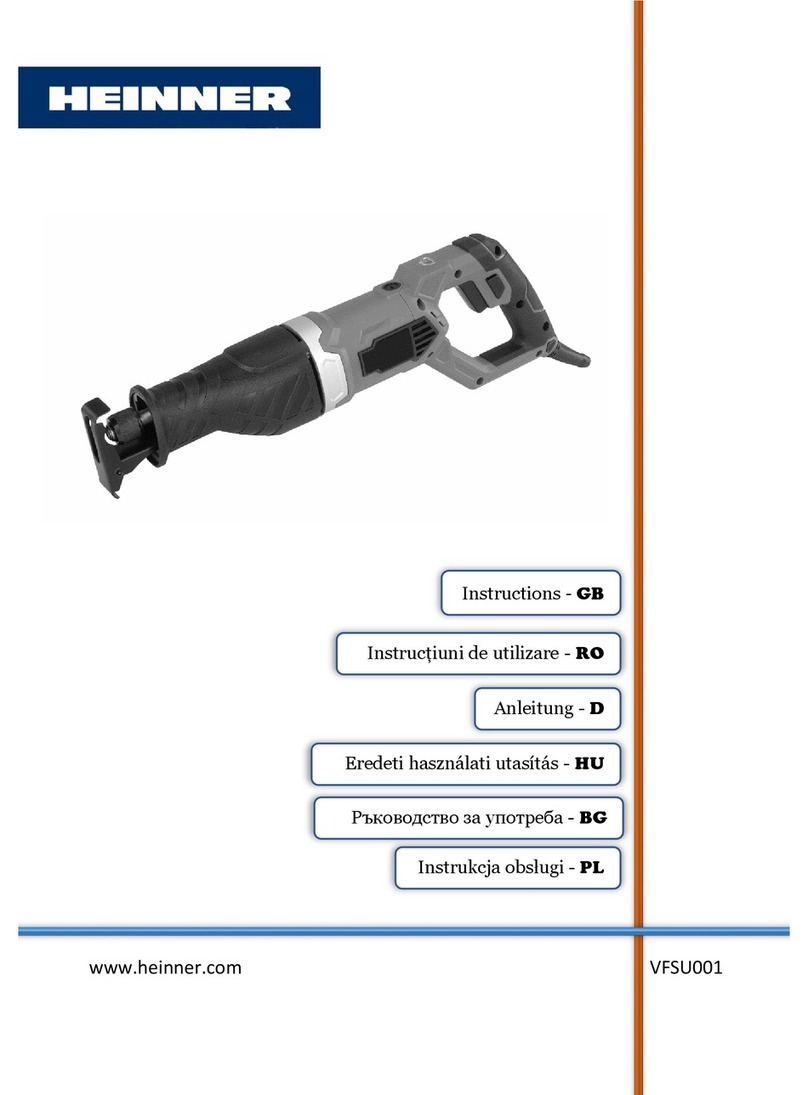
Heinner
Heinner VFSU001 instruction manual
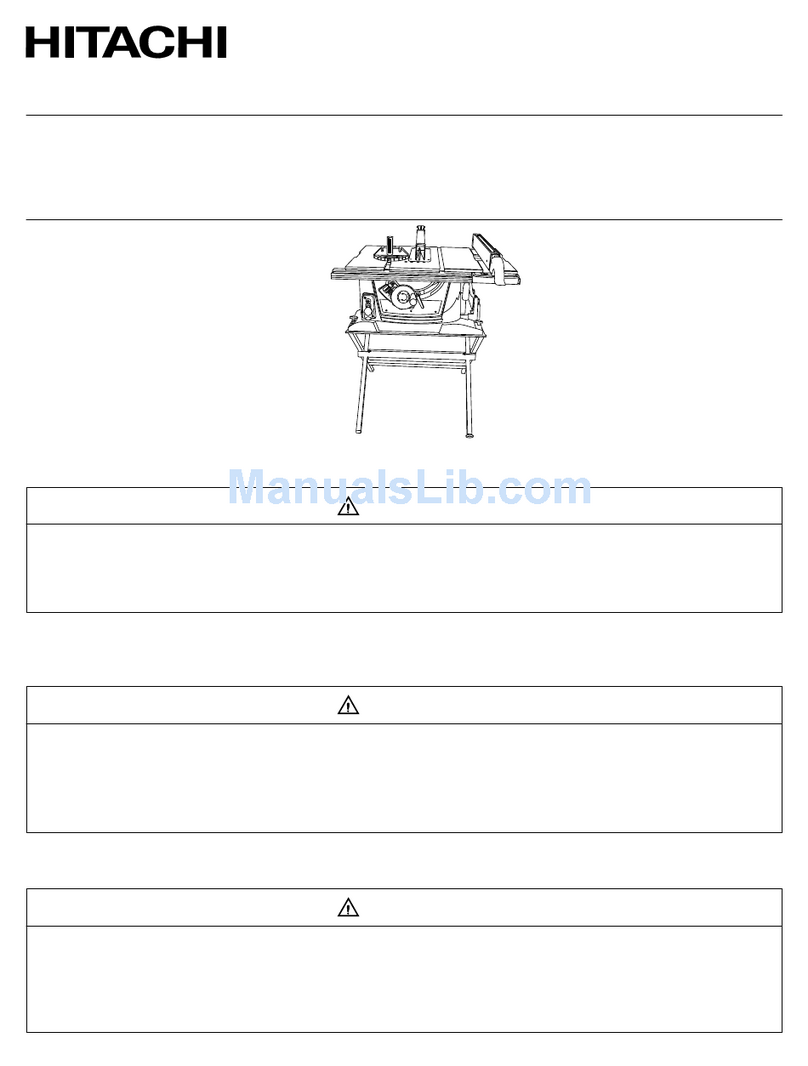
Hitachi
Hitachi C10RB - 10" Professional Jobsite Table Saw instruction manual
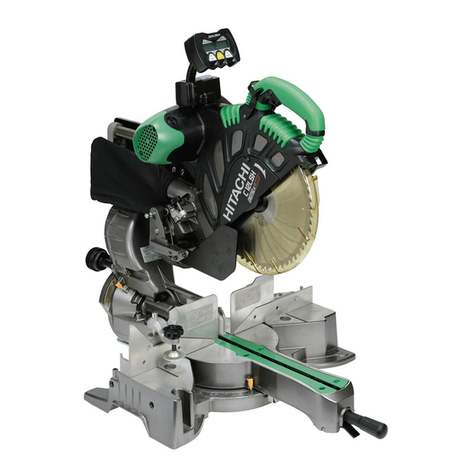
Hitachi
Hitachi C12RSH - 305mm Slide Compound Mitre Saw Handling instructions

Hilti
Hilti SCW 18-A operating instructions
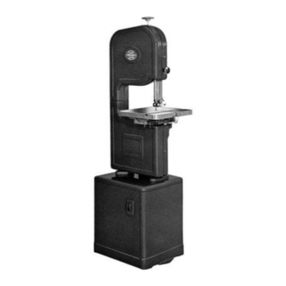
Powermatic
Powermatic 141 Operating instructions and parts list
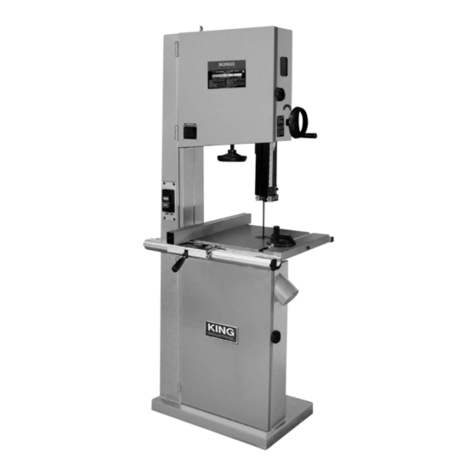
King Industrial
King Industrial KC-1702FXR instruction manual
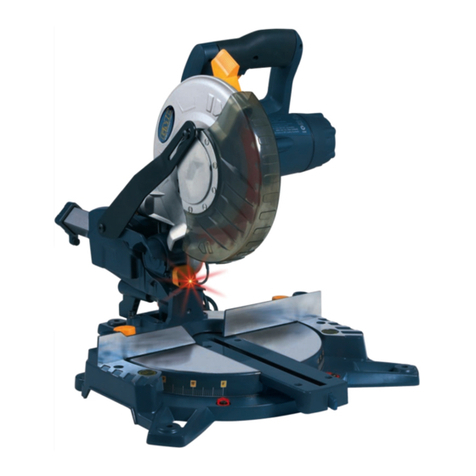
GMC
GMC LS211 instruction manual
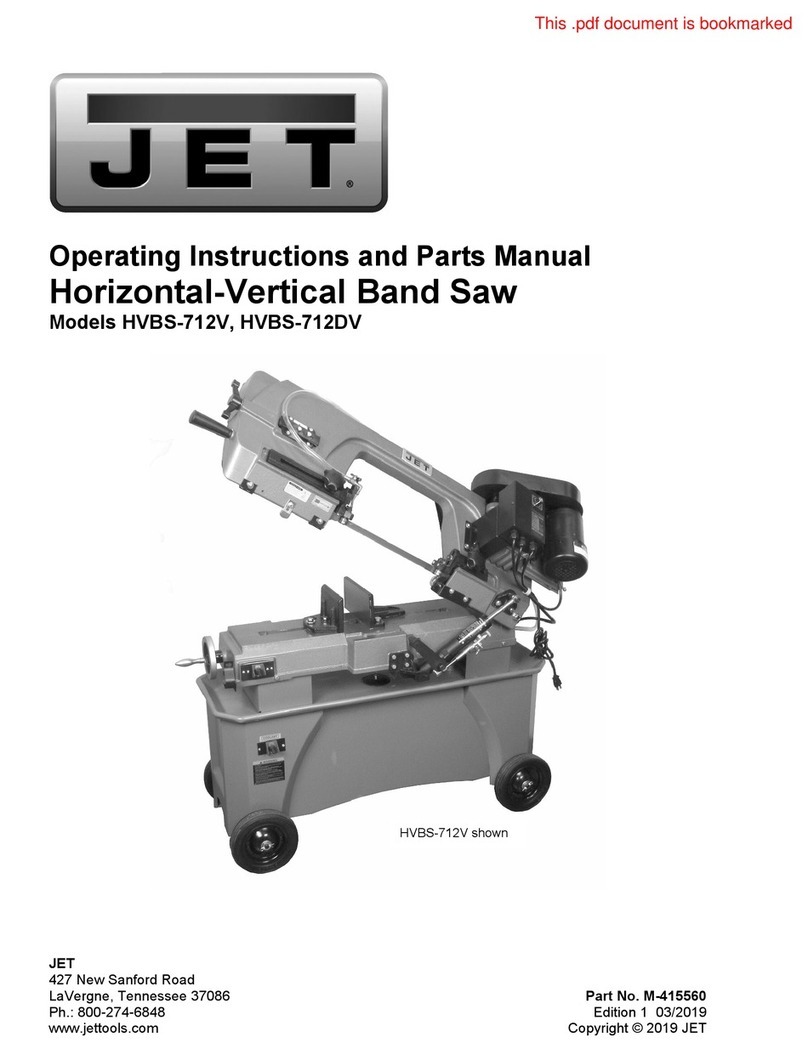
Jet
Jet HVBS-712V Operating instructions and parts manual
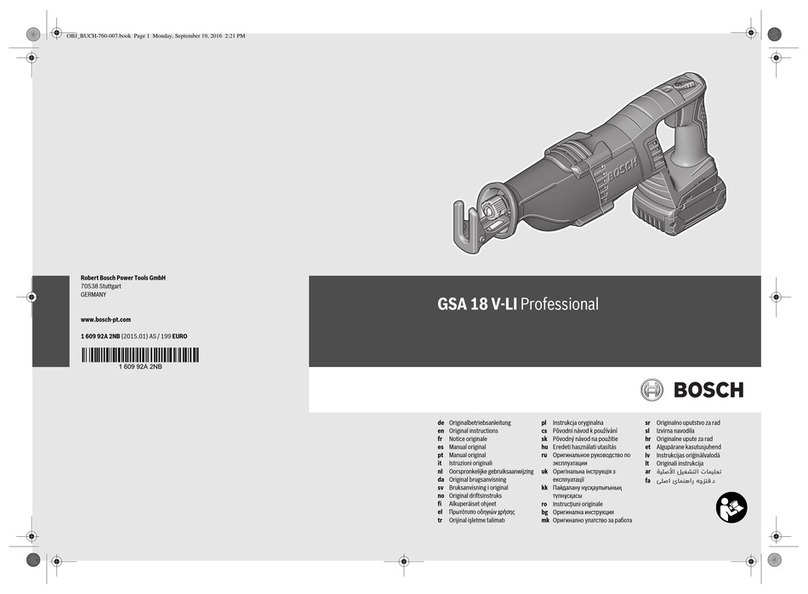
Bosch
Bosch Professional GSA 18 Original instructions
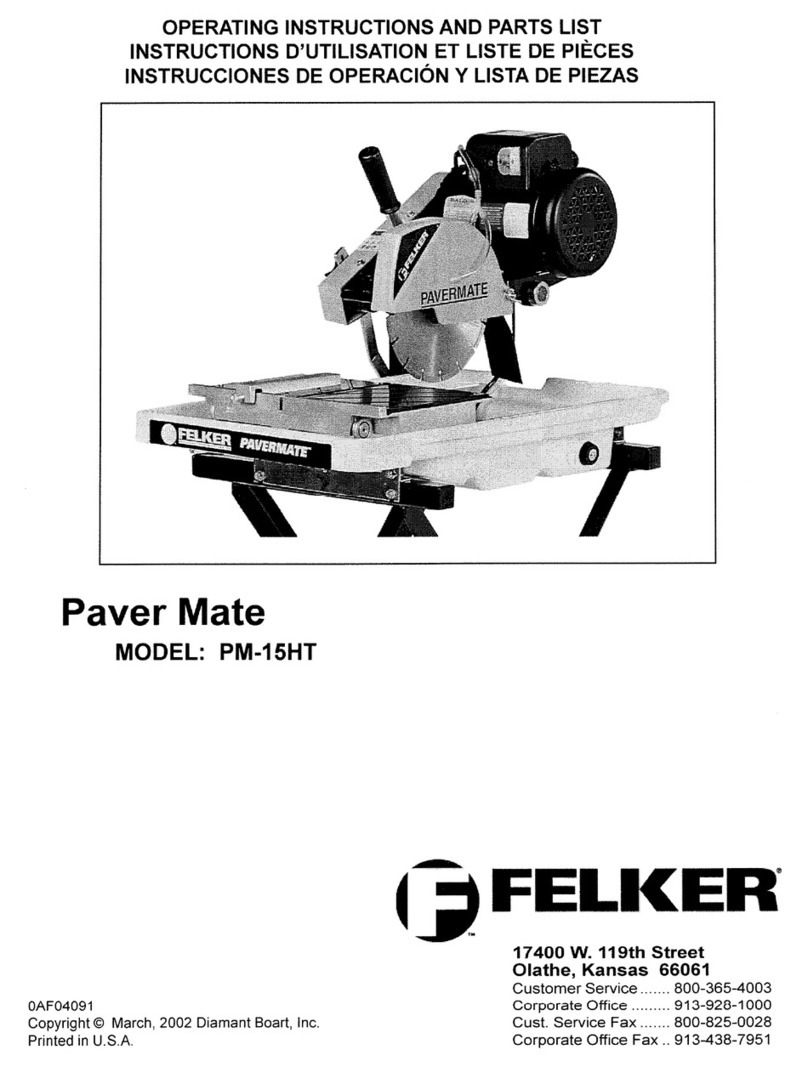
Felker
Felker PaverMatePM-15HT operating instructions
